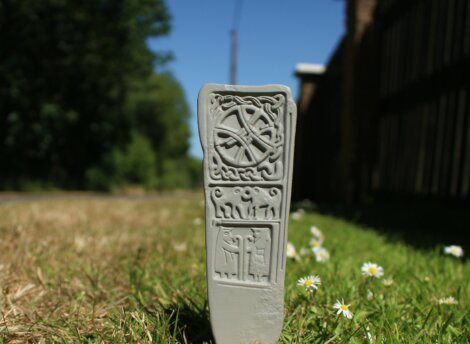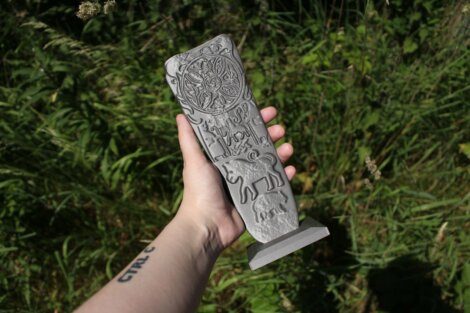History / A unique souvenir: artist creates miniature replicas of Bressay Stone
A SCOTTISH artist recently produced 3D printed replicas of the Bressay Stone, and they are now available to purchase.
The original Pictish stone was discovered in the 1800s near St Mary’s Church in Bressay.
It is likely from the ninth or tenth century, with figures, patterns and writing inscribed on it.
The text reads “the cross of Necrudad, daughter of An (in memory of her husband) Benises son of Droan” in the Ogham Early Medieval alphabet.
The stone is currently part of the National Museum of Scotland’s collection in Edinburgh.
Visitors and local history buffs can now bring a piece of history home with them thanks to Alice Martin’s work.
Martin, who is an artist based in Stirlingshire, was commissioned by Bressay History Group to create the replicas.
She told Shetland News: “A fascination with the visual and conceptual possibilities stemming from the interdisciplinary fields of art, archaeology, museology and heritage drives my artistic practice.
“I research, remix and create artefacts, original pieces and sites through 3D printed sculptures, modelling, scanning, moving image, installation, casting, digital prints and printmaking.
“Currently, my interest lies in comparing stone designs from the Neolithic to the Picts and the fragility of Roman glass from bowls and bottles for example.”
Martin was contacted by the history group through their Etsy shop, after the group had seen some of her previous Pictish sculptures.
They describe the Bressay Stone as having “fantastic Pictish and Viking-influenced imagery”.
https://twitter.com/alicecmartin/status/1684569495845892096
“To begin the process, I researched and examined various reference materials such as Sculptured Stones of Scotland by John Stuart, to gain a better understanding,” Martin explained.
“I then employed 3D modelling software to sculpt the stone from scratch with accurate dimensions.
Become a member of Shetland News
“The variety of symbols and different heights were tricky to capture and took several attempts but I was very happy with how it turned out in the end.”
The sculptures are made of resin and then airbrushed after printing.
They are just 15cm tall, compared to the original stone which is 1.22 metres high.
Martin also made a larger display model from recycled materials for the Bressay Heritage Centre.
“I had to add a base so the finished product would stand upright since the original didn’t have one,” she continued.
“With the assistance of the Makerspace at Bannockburn Library and the use of my desktop 3D printer, I managed to 3D print the digital files then airbrush, varnish, sand, file, spray paint and assemble each one individually to achieve a replica that resembled stone and wood material with some weight to it, thanks to the resin.
“I used recycled and biodegradable PLA filament too.”
Martin’s previous projects have included combining two Pictish stones to compare the designs and reconstructing an Islamic glass beaker with just three surviving fragments.
The Bressay Stone replicas can be purchased in person from the Bressay Heritage Centre or by emailing bressayheritage@btinternet.com
Become a member of Shetland News
Shetland News is asking its readers to consider paying for membership to get additional perks:
- Removal of third-party ads;
- Bookmark posts to read later;
- Exclusive curated weekly newsletter;
- Hide membership messages;
- Comments open for discussion.
If you appreciate what we do and feel strongly about impartial local journalism, then please become a member of Shetland News by either making a single payment, or setting up a monthly, quarterly or yearly subscription.













